What's new in Visual Studio 2012 RC
 I would be happy to announce the release of Visual Studio 2012 Candidate Release, Team Foundation Server 2012 and .NET Framework 4.5. These products are already available for download from the Visual Studio website.
I would be happy to announce the release of Visual Studio 2012 Candidate Release, Team Foundation Server 2012 and .NET Framework 4.5. These products are already available for download from the Visual Studio website.With the release of Visual Studio RC, a new preview version of Windows 8 Release preview has also become available today. Please visit the Building Windows 8 blog in which the official announcement of Stephen Sinowski is published. You can download Windows 8 Release preview now .
The full list of Visual Studio 2012 RC features is published on MSDN . In this post you will learn about the main innovations compared to the beta version. Based on the current production cycle of the product, these changes are the final touches aimed at improving the performance of existing capabilities and performance, as well as changes based on the feedback we received during the beta testing period from the community. You can see some of these changes in action on video (in English).
Logo and branding
You probably noticed that we made changes to the branding and moved away from the name "version 11". Now RC is called Visual Studio 2012. And this means that the RTM version will be released this year!
We also changed the product logo:

Installation
One of the first components with which you are familiar with in almost every product is the installer. We added the ability to upgrade from beta to RC, so if you use the same product edition (Professional, Ultimate, etc.) you do not need to uninstall. Just run the Visual Studio 2012 RC installer, it will remove the old components and update them to the new ones. The only exception is if you are working on Windows 8, in this case you need to upgrade the OS itself to the Windows 8 Release Preview version and then install Visual Studio 2012 RC.
We also added significant changes that improve the overall installation process. Many of you have already seen the new installer interface in beta, in the RC version the installation time of the product is reduced by 20%!
Now you have a choice of components. We hope that you will enjoy these innovations and will save your time.
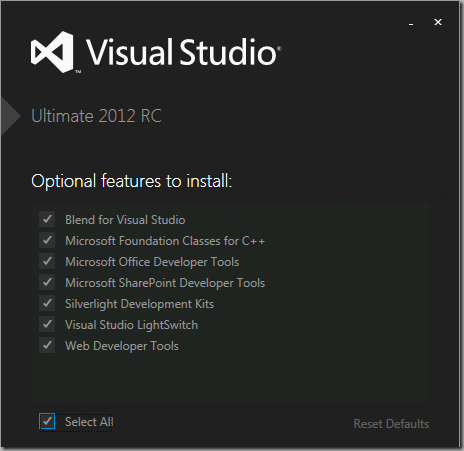
')
Performance
Between the beta and RC versions, much work was done to improve performance, which covered almost every aspect of the product. We added improvements to working with XAML (compiler, document loading, designer), increased the performance of the debugger and Test Lab Manager, the code editor when working with large C ++ files. In fact, this is not a complete list.
In order to give a few examples, we plan to publish several notes, the first of which concerns the editor’s performance and responsiveness. We suggest that you familiarize yourself with this post from which you can learn about some of the internal performance analysis tools, changes in the product that were made and the results that affected the editor's overall responsiveness. The next post will be about improvements in Toolbox components.
Interface
RC includes several improvements related to the general interface of the product, and is based on your feedback, which we carefully analyzed after the beta version was released. More details about these changes can be found in this post where the details about the innovations in the interface.
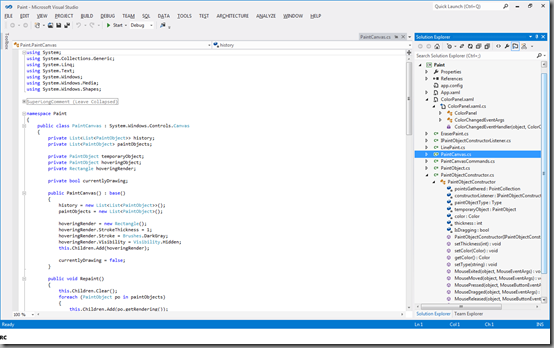
After this publication, we received many requests to tell about the dark theme of Visual Studio, which many people like. Earlier this week we published a post that you can meet .
IDE
The improvements in the IDE focused on the feedback we received during the beta testing period.
For example, we received a review related to the search operation and the current context and options between the Quick Find and Find-in-Files options. An extension has been released which is now included in RC and now you can perform a quick search that does not automatically change the context and settings in Find-in-Files.
Solution Explorer is an example of the area in which we made a few additional changes and debugged them for RC. It was discovered that the Solution Explorer toolbar was overloaded, so we deleted several commands that are already in the context of the IDE (context menus, keyboard shortcuts, menus) and did not affect the presentation of the solution or the project hierarchy.
For large Solutions consisting of many projects, it was quite difficult to search for the necessary files, so RC included the possibility of additional filtering and limiting the scope to increase relevancy and allow focusing on important work. Now you have the opportunity to limit Solution Explorer to show only those files you are working with. New filtering options include Pending Changes and Open Files.
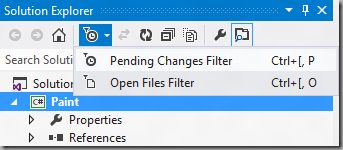
Additionally, we improved the performance of the Quick Launch search, which now works almost instantly.
Metro style apps
If you are planning to create Metro style apps, be sure to install Visual Studio 2012 RC on a computer with Windows 8 Release Preview. There are several additions to creating Metro style apps in the RC version.
Metro style apps using XAML
First of all, we added several new Metro style application templates, including the Windows Runtime Components template for C # and VB, and a new project DLL template for C ++ developers. There are also improvements in existing templates. For example, templates fully support navigation using the mouse, keyboard, and touches. XAML support has been added to Direct2D project templates. The XAML Blank App template has been greatly simplified.
XAML editor for Visual Studio and Blend has been extended to RC with new features. Now you can edit the source code and see preliminary results in the preview window for different states, such as FullScreenLandscape, Filled, Snapped. This feature is available through the Device panel option, which enables the required mode if the visual presentation changes. The following is an example of the snapped state:
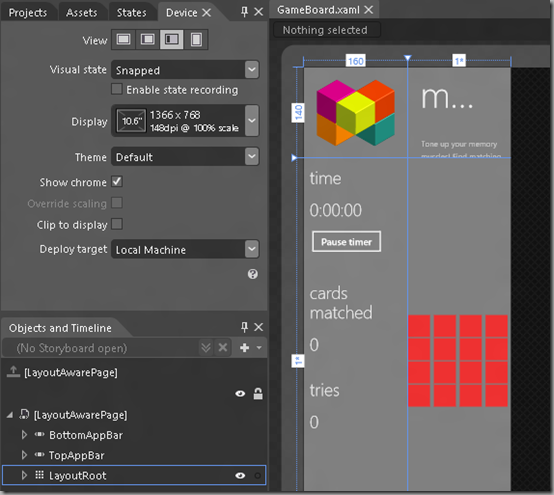
If the option “Enable sate recording” is selected, the mode of saving changes to the current state, and not to the base state, will be enabled.
Adding themes of animations from the library associated with the states of your application is now possible with the help of the state designer Blend. The animation library includes many options and uses the rich capabilities of the Windows 8 platform. Select the required state for your view in the States panel, then the Storyboard object and properties will be able to familiarize and configure the necessary animation:

The capabilities of the Metro style application platform also include several improvements, such as better support for the IRandomAccesStream from .NET, a more aggressive memory return when the application is in a “frozen” state. Programmers received new tools for testing application performance included in the Windows App Certification Kit. Another nice addition is the ability to enable multi-core JIT for Metro applications and improvements in NGEN algorithms.
Metro style apps using javascript
Blend has been expanded with new features that make it easier to work with cascading style sheets. For example, in the Winning Rule mode “Arrange by: source” in the CSS property panel, you can easily find which elements are currently active and where they came from.
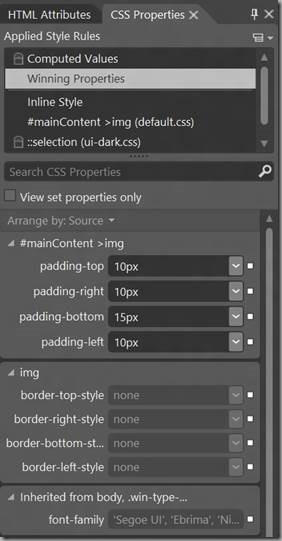
Also added features for editing gradients and two-dimensional transformations:
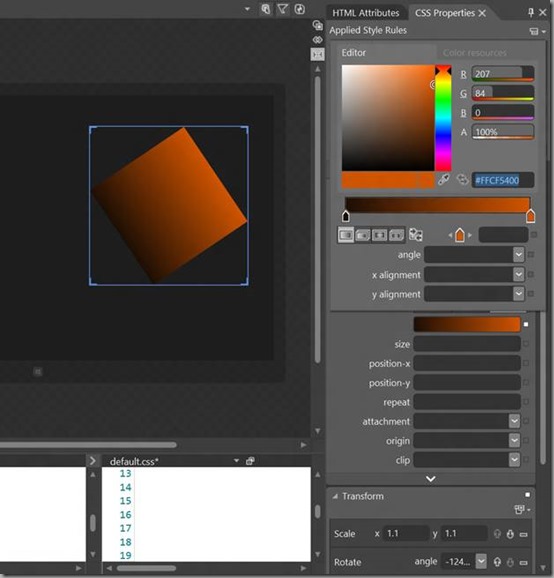
Finally, we did a lot of work to improve refactoring and overall convenience. For example, now using the context menu you can quickly change CSS class names or create new rules for element ID or classname. Also, you now have the ability to cut, copy, and paste CSS properties in a manner that facilitates moving CSS properties between CSS rules.
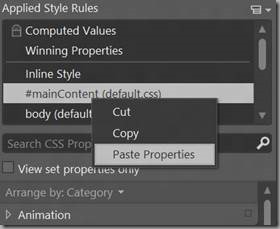
Additional information about innovations in RC for metro-style applications was published in Windows 8 App developer blog
ASP.NET 4.5
ASP.NET Web Forms has been updated to fully support the new features of the C # language and the async and await keywords. Page and item events can now be marked as asynchronous and allowing to use new features of the .NET 4.5 platform.
MVC 4.0 now includes support for Entity Framework 5 with the "migrations" mode enabled, allowing programmers to synchronize the data schema in the database and source code
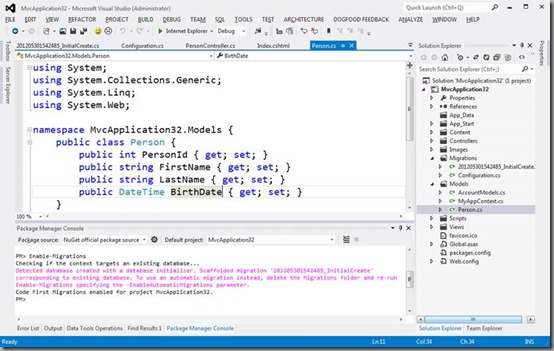
ASP.NET MVC from this point on, by default, renders pages in HTML 5, for example, the above model will generate the following code on the web page id = "BirthDate" name = "BirthDate" type = "datetime" value = "5/31/2012 12: 00:00 AM »
Tools for Web Developers
If you are engaged in web development, you will definitely notice for yourself those innovations that are included in RC. First of all, these are changes in templates. The MVC4 Empty Template is now really “empty” (the old template is now called Basic). Also improved the performance of creating new projects.

The IDE has added switches for launching a web application with support for multiple browsers:
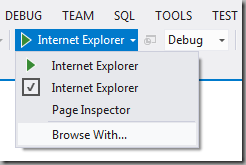
The mechanisms for publishing applications have also been updated with the addition of an incremental mode of updating data sources. The full list of innovations is given in the Web Development Tools blog.
LightSwitch
For projects LightSwitch also made a number of changes and additions to the RC. In the last days of March, we published a new theme for the LightSwitch projects - Cosmopolitan Shell & Theme in order to provide these applications with a modern corporate look. Since then, we have fixed a number of problems and wishes from the community. Based on general feedback, this application theme will now be used by default.
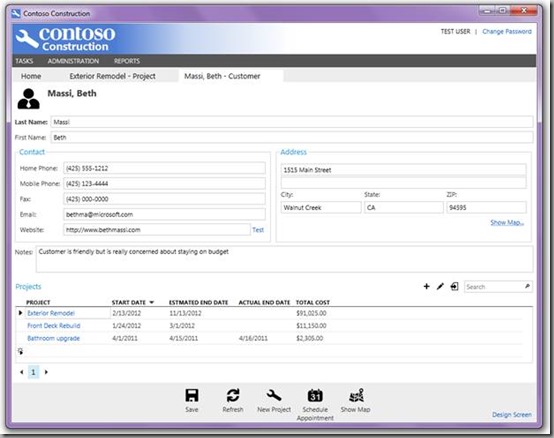
Another innovation that is also based on feedback is the ability to add a logo to the authorization page of the LightSwitch application. This window is displayed after the application is published. Additionally, performance indicators for data operations were improved, which had a positive effect on many usage scenarios, such as queries, paging, data loading to grids / editors, etc. For more information on LightSwitch and RC updates, visit the blog at blogs.msdn.com/b/lightswitch.
Team Foundation Server
There are several TFS updates after beta. The first of them is the ability to use SQL backup of an existing installation of Team Foundation Server to upgrade to the new version. The second feature allows you to automatically add new features to existing projects based on old process templates when upgrading - this is the most popular feature for TFS reviews.
The TFS team also improved the Web Access interface and added the ability to collapse iterations:
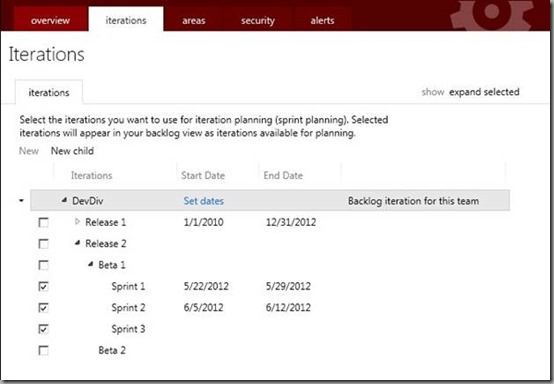
Additional information about updates related to TFS is published on the Brian Harry blog.
Facilities for architects
The RC includes new features for analyzing the structure of the application and the relationship between the components. Now you can use contextual commands or select the code elements you are interested in on the dependency graph to search, for example, of all types inherited directly or indirectly from another type, or methods that the currently selected method calls.
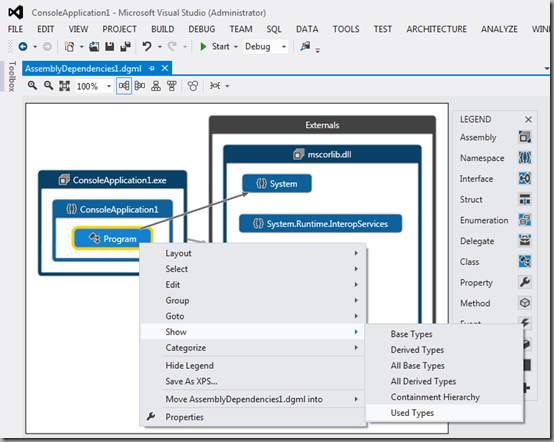
You can also see which links exist between higher-level components and visibility areas, plunging into links and finding the sources of dependencies:
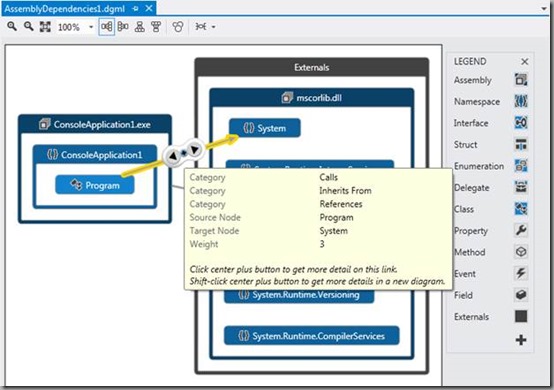
If you touch the interface, it is now possible to enable various views for components of interest, including the compact “List View” mode:
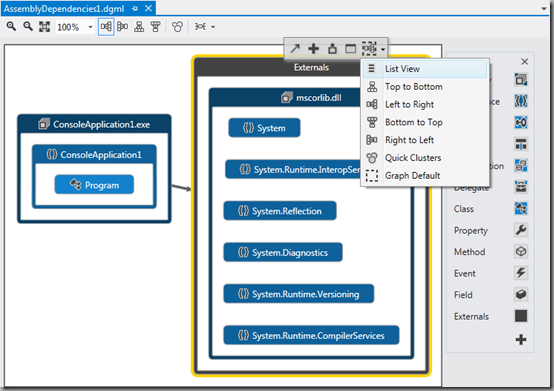
"Go Live" license
Just like the beta version of Visual Studio 11, the release candidate Visual Studio 2012 comes with a “Go Live” license, meaning that you can now use the product to create commercial applications. For a more detailed understanding of the term “Go Live” you can read the information published on the website of Visual Studio 2012 RC .
Some additional resources:
Below is a list of interesting links to help you get started with RC:
- Visual Studio 2012 RC Product Website
- Visual Studio Developer Center
- Visual Studio ALM Rangers solutions page
- .NET Framework Developer Center
- Windows dev center
Your opinion is very important to us!
We really hope for feedback and your feedback. Please use any resources to express your opinion.
- Ask questions on the MSDN forums
- Tell us about the errors found.
- Post your suggestions for improving Visual Studio on UserVoice
Source: https://habr.com/ru/post/145036/
All Articles